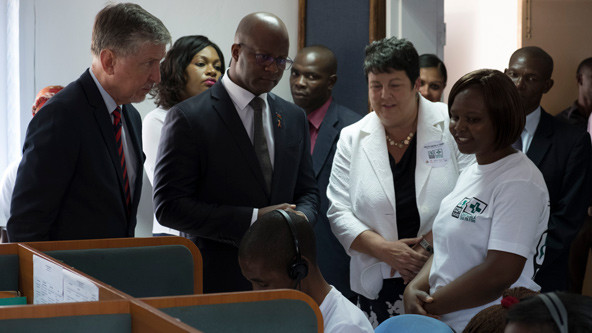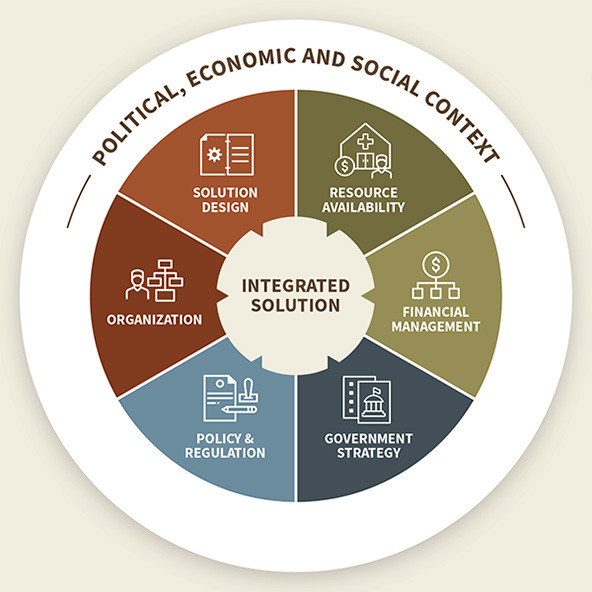 Malawi’s Minister of Health and Population Atupele Muluzi, Airtel partners, and ambassadors to Malawi listen to hotline calls in 2018. (Photo by VillageReach)
Malawi’s Minister of Health and Population Atupele Muluzi, Airtel partners, and ambassadors to Malawi listen to hotline calls in 2018. (Photo by VillageReach)
On a rainy day in February 2018, standing among dignitaries, partners, donors, and community members, it hit home that one of our health programs was ready to fledge. We realized it as Malawi’s now former Minister of Health and Population Atupele Muluzi unveiled a plaque on a new government building, out of which the national health hotline we developed would operate going forward. We watched its ownership slowly evolve over the course of many speeches during the ceremony. At one point, Muluzi stated the program was “an important part of achieving universal health coverage in Malawi.” But were we ready to hand over the keys to a solution we had nurtured for nearly a decade? When was the right time? And how would we know?
“Sustainability” has long been a buzzword in the development community, but the road to long-term social impact is not always clear. Success often depends on an organization’s ability to support governments as they assume responsibility for and eventually own a program’s ongoing operations and management. If it can’t, the solution and its positive impact on the community can disappear or require external funding in perpetuity.
As our organization, VillageReach, seeks to improve quality access to health care in sub-Saharan Africa, we grapple with how to thoughtfully scale and sustain innovations by working with and through the public sector. The program we mentioned above, Chipatala cha pa Foni (CCPF), initially focused on serving the rural district of Balaka with maternal and child health information, but through the work of a broad coalition of partners, donors, and government agencies, it has expanded to cover the gamut of health-related topics—including infectious diseases; water, sanitation, and hygiene; and nutrition. The program also introduced youth-friendly health services in 2017, increasing young people’s access to sexual and reproductive health information.
Today, Malawi’s Ministry of Health and Population is in the final stages of adopting it as its own—a transition VillageReach has supported for more than two years. One important lesson from our work is the importance of planning for government ownership from the start. Although we started at the district level rather than the national level, everyone involved in the project shared the goal of eventually seeing the national government take ownership as the path to scale.
Are you enjoying this article? Read more like this, plus SSIR's full archive of content, when you subscribe.
Figuring out when and how to step back from the role of implementer, however, is complex. To gain confidence about our process and inform future transitions, we scoured existing literature and talked to transition experts to develop a framework that guides our efforts today—and that other organizations in the health sector and beyond might find useful. Below is an overview and how we have applied it to CCPF.
Defining the Framework
At the core of our framework is the idea that solutions must exist within an “enabling context.” The enabling context comprises external conditions such as a country’s level of political stability, government independence, and economic prosperity. Each of these can have a major effect on whether a government entity succeeds in sustaining a solution after an NGO or private-sector partner exits. While these external factors are generally outside most organizations’ control, monitoring them can inform decisions about how to invest time and resources, with the aim of minimizing their negative impacts on a government’s ability to sustain projects.
 As organizations assess a social solution’s readiness for transition to government, they should consider both the external environment and each of the solution elements. (Illustration by The Medium)
As organizations assess a social solution’s readiness for transition to government, they should consider both the external environment and each of the solution elements. (Illustration by The Medium)
We are using tools like the PESTEL framework to help identify external factors that could impact the success of programs, as well as reviewing resources from USAID, World Bank, World Health Organization, and other agencies to better understand the political, economic, and social context for transitioning solutions to our government partners. For instance, the government of Malawi has made high-level political commitments to support maternal, adolescent, and child health, but as a low-income country, it has limited funds to spend on health. Thus, reducing costs is critical. VillageReach initially developed a memorandum of understanding (MOU) with the telecommunications provider Airtel—one of two major mobile service providers in Malawi. Since signing the MOU in 2015, Airtel has covered all incoming call and promotional text costs of the hotline, allowing callers to call CCPF for free from any Airtel phone. The government is now managing the MOU with Airtel as part of the transition process.
The second tier of our framework combines all the elements integral to a solution’s success that (unlike the enabling context) are within the control of an implementing organization. We call this the “integrated solution,” and it has six elements:
- Solution design: This includes standard operating procedures, guidelines, templates, and job and skill descriptions needed to manage and operate the solution. We are developing a toolkit specifically to support the government in managing CCPF.
- Resource availability: This includes the financial and human resources, as well as infrastructure like buildings and equipment, needed to transition, operate, and maintain the solution. For CCPF, we are supporting the development of a memorandum of understanding between the government and the telecommunications provider Airtel to ensure that the company continues to cover the costs of calls to the hotline.
- Financial management: This covers developing and managing budgets, estimating and managing costs, and disbursing funds in a timely fashion. This process has been important for understanding exactly which budgets need what amount of funds to ensure that operations continue.
- Government strategy: This includes sector (in our case, health-sector) and related government strategies that support the solution’s transition, operation, and maintenance. For CCPF, we needed to ensure that these aligned with Malawi’s broader strategic plan for the health sector.
- Policy and regulatory strategies: These are laws and regulations that affect the solution’s transition, operation, and maintenance. For CCPF, we needed to ensure that the cadre of hotline workers fit into government staffing protocols and that we could legally share certain types of health information with callers.
- Organizational structure: This includes managerial roles and responsibilities, management effectiveness, and governance. CCPF established a steering committee to help maintain alignment and accountability.
Organizations should evaluate and plan for the enabling context and integrated solution concurrently—ideally prior to or early on in the process of developing their solution, and periodically throughout its life. We know this because, in some cases, VillageReach has thought about these elements later than we should have—including after transitions to government began—and it has impeded government’s ability to operate the solution and ultimately reduced impact. We’ve created guiding questions for each element of the transition framework to help identify potential weak spots. In examining solution design, for example, we ask, “Do the solution guidelines allow for exceptions based on contextual realities?” This helps ensure that we create guidelines for adapting the solution to known risks, and improve government’s ability to proactively identify and resolve problems.
This framework is guiding our ongoing transition plans. In light of the appointment of a new health minister, we are working to ensure that people from multiple Ministry of Health divisions are aware of CCPF’s impact and to align the program within the government so that funding continues after the transition. The framework is also helping us strengthen gaps in areas like financial management, where costing, budgeting, and funds management were sub-optimal.
Five Keys to Successful Transitions
Based on our experience transitioning CCPF and other programs, here are five things organizations can do improve their chances of success.
- Continually assess transition readiness: Applying a transition framework before and during the process helps identify bottlenecks, develop remedial action, and provide a holistic view of enabling and hindering factors. We also plan to conduct an evaluation a year after we have fully transitioned CCPF. Assessments should be transparent and collaborative—neither viewed as an evaluation of the government, which may cause resistance, nor completed only by the partner that is stepping back.
- Evaluate and support skills and capacity. Sometimes government agencies won’t have the skills or capacity to effectively manage the transition process. We found it helpful to appoint a liaison within the Malawi Ministry of Health and Population to facilitate transition actitivities such as drafting memos, setting up meetings with other divisions, and following up as needed.
- Exit gradually. Phase the transition, allowing for sufficient lead time so that government can institutionalize important processes and activities before support ends. This can take several years. With CCPF, the hotline moved to government property a year before budgets to support the program were finalized, and establishing positions for hotline workers within the health ministry is taking longer than expected.
- Maintain flexible funding for future support. Partners should think about aspects of the solution that would benefit from additional support during and after transition. Expect costs associated with transferring day-to-day operations to governments and assess the flexibility of your donors to support different phases of the process. For example, technology improvements (such as building in artificial intelligence to help CCPF manage increasing demand) may not align with the government’s budget priorities.
- Benchmark the risk: By looking at whether the elements outlined in the framework are in place or not, stakeholders can get a sense of the risk involved in the transition. For example, if financial or human resources are below a specified benchmark, then an exit might not make sense or could result in compromised impact. In the case of CCPF, we did not have these benchmarks upfront, but we assessed the seriousness of the gaps and stakeholders’ ability to resolve them within the transition period. The required actions seemed achievable.
As a recent article on partnering with government in India points out, sometimes NGOs have to make difficult decisions to gain government adoption without compromising program effectiveness. We are in the early stages of using this framework to make better decisions about our own exit strategies and plan to evaluate how well we do. But one thing we know is that transitioning a solution to a government agency can be the best way to increase a solution’s reach and ensure long-term social impact.
Support SSIR’s coverage of cross-sector solutions to global challenges.
Help us further the reach of innovative ideas. Donate today.
Read more stories by Melissa West, Emily Lawrence, Julia Guerette, Barbara Jones-Singer & Bvudzai Magadzire.

